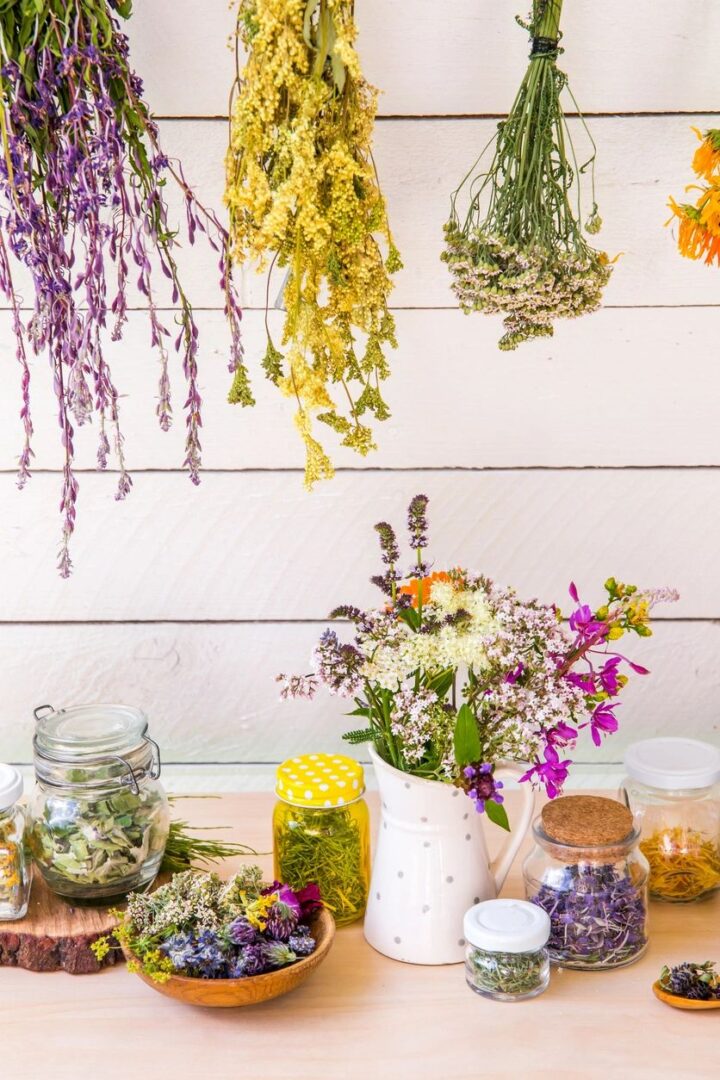
Drying And Preserving Herbs
Drying and preserving herbs that you have grown in your potager garden or pots adds variety to your pantry. These are the various herbs including basil, marjoram, rosemary, thyme, oregano, mint, chives, sage, parsley, and even peppers that add great flavor to your recipes. The herbs can be dried and kept in bottles or sealed packages. They can also be frozen for future use.
Harvesting Your Garden
Pick the herb leaves and stems in the morning before they have sun exposure. Carefully discard any leaves or stems that are damaged or imperfect. You want the best leaves for the fullest flavor.
Wash the leaves and stems with cold water. Pat dry on a paper towel.
Dry Herbs with Dehydrators
There are several ways to dry herbs, beginning with a food dehydrator. You can purchase various types of dehydrators at most big box appliance stores or online.
Set the dehydrator thermostat to 95 to 155 degrees F. Place the herbs on the racks and follow the instructions for the appliance. Do not cut or crush the leaves. They will crumble when they are dried. Check the dehydrator occasionally to see how well they are drying.
You will enjoy the odor of the leaves as they dry. Your kitchen or other room where the dehydrator is located will be filled with the fragrance of mint, bay leaf, or oregano.
Oven drying
You can use your oven to dry herbs and enjoy the scents as well. Spread the herbs on a tray or cookie sheet. The oven should be set at 115 degrees F. It will take three or four hours to dry the herbs in your oven. Check the herbs periodically.
Microwave Drying
In a hurry? Put the herbs on a paper towel. Cover with another towel and dry on low wattage (1000 watts) for two or three minutes. Check the herbs at 30-second intervals.
Air Dry Indoors
This is the best way to air dry in a damp climate. Be aware that it can take a week or more to dry the herbs. You can hang bunches or herbs by the stems to allow them to dry naturally. Mint, thyme, sage, and other herbs can be dried using this method. Bunch the herbs and tie the stems with a string. Place the herbs in a plastic bag with the stems out. Secure the bag around the herb bunches but cut holes in the sides of the bag to allow for air circulation. The bag will catch the herbs as they dry, crumble, and fall off of stems.
You will find air drying racks for herbs at most garden centers or online. The racks allow for good airflow to dry the herbs over a few days or more. The racks are generally placed near a window to allow sunlight to dry herbs. The air in your home should also be relatively dry.
Air Dry Outdoors
You need warm, dry air and sun to effectively dry herbs outdoors. You must also keep the herbs away from insects with a fine screen that allows the sun to penetrate. Several types of drying racks work well outdoors.
You can also allow fennel, dill, coriander, mustard seed, and caraway to dry naturally on the vine in your potager garden. Do not harvest these herbs until they are completely dry, and even the stems have shriveled. Do not harvest any moldy leaves or seeds.
You may want to complete the outdoor drying process indoors using the oven or a dehydrator. This will destroy any insect residue.
Freeze Dried
This is another way to preserve herbs. They will be limp when thawed, but they are still good in stews, soups and other dishes. Add water or a little olive oil to cut up or crushed herbs and freeze them in ice-cube trays. You can also freeze herbs in plastic bags or containers.
Freezing herbs that dried outside or on the vine is also a good way to kill any invisible insect residue or other germs. Herbs dried outside should always be washed and dried first before they are frozen.
Take the opportunity to learn more about herbs that you can grow in a potager garden that adds beauty along with practicality. What are the best herbs to grow in your region?